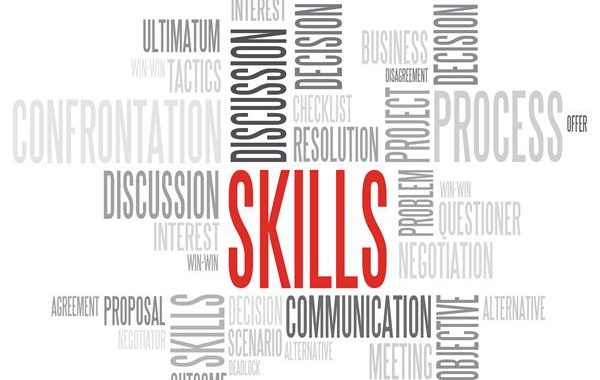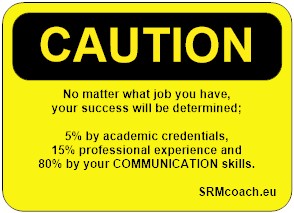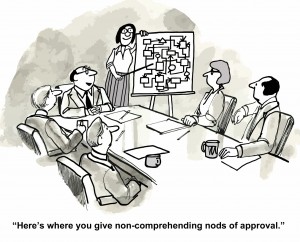
People involved in setting up Safety Management Systems often come from a technical background. As a beginning Safety Practitioner myself, I was a typical technical person with a voracious appetite for all kinds of technical information. In this post I’d like to argue that, to be effective as a safety manager or practitioner, you have to be able to deal with both sides of the socio-technical system that is SMS. For the social side that often involves so-called “soft skills”.
 When I started working in a safety department, I loved it because of the varied technical nature of the information I dealt with.
When I started working in a safety department, I loved it because of the varied technical nature of the information I dealt with.
Later on though, I noticed that the courses which really helped me the most as a safety practitioner, were not the technical courses (approach procedures! Flight Data Management Units! the quirks of the BAe146 bleed air system! Ah, those were the days…).
Rather, the most useful courses to help me become a better safety professional, were the ones that commonly are referred to as the “soft skills” or “fluffy” skills if you are an engineer.
Engineers generally are suspicious of these skill sets, because they are difficult to measure, and there is no guarantee that doing the exact same thing will generate a similar outcome. Despite the name though, soft skills could just as easily be called the “harder” skills, technical skill being considered the “hard” skill.
I still remember fondly a course called “Management Skills” training, by a wonderful lady called Maggie Lamb, former purser on the Concorde.
This course actually had nothing to do with aircraft at all, but nevertheless I appreciated it a lot.
I started to learn (still learning) about what makes a management team meeting actually tick, and how and why can you influence the dynamic by using some very simple stuff.
It dealt with how to run a meeting (even if you are not the most senior person in the room), how to make an effective presentation, how to get decisions and the outcome you want/need from a meeting.
We had a video tape made of our mock “meetings” and it was very confrontational as well as very useful to be aware of the stuff you do that works, or does not work.
None of it was rocket science but even knowing it on an intellectual level, doing it and analysing it made a world of difference.
Similar trainings, such as “train the trainer” and “public speaking” courses were also tremendously helpful to cut down the “technical waffling” and get to the point quickly and clearly without wasting everyone’s time.
(…life long undertaking for me, I think I am making progress, but on the other hand you might have fallen asleep by now).
I have come to believe that to be effective as a safety professional you also need a good grasp on these “soft skills”.
Why?
Because once you have done the technical job of identifying a safety issue, root causes and contributing factors, it’s not over.
In order to actually make the organisation safer, action needs to be taken.
An SMS which is just documenting problems but not doing anything about them can’t possibly improve safety performance or be considered effective.
The safety manager does not have any authority to implement action directly and he/she needs to work with the management team of the organisation to make things happen.
Too often the assumption is that you can just present a technical case or a risk assessment to the management team, and it will be solved automatically.
Remember that your managers might not come from the same technical background, and simply do not understand what you are talking about and why you are so exited about it.
To them it is just one more problem on a very long list of daily issues. Furthermore, there are a whole host of mental biases that your management team can have that changes their perception of the problem. ((see Challenger for a more spectacular example of that)
The safety professional’s job is to convince the management team that:
a) there is a problem
b) “something” needs to be done
c) the best “something” is the recommendation of the safety team
d) someone needs to “own” the problem
e) that someone needs to understand the issue and give it an appropriate priority (among his/her undoubtedly huge todo list of other “non-safety” work
d) that someone then implements that recommendation effectively (as opposed to a tick-the-box solution)
e) the management team needs to convincingly communicate to the organisation the safety issue is being dealt with
Once the recommendation is implemented, one might assume the organisation is safer, right?
Well, not so fast…
the safety issue might still not be resolved for a variety of reasons, and you need your management team to understand sometimes there is some trial and error involved.
Remember “management buy-in”? A term casually mentioned in the ICAO 9859 document, as in “obtain management buy-in” insinuating it is as easy as buying groceries.
Watch how fast it disappears if your management team sees no results for their SMS time and efforts.
As a safety manager you need to understand the psychological aspects of the process and prepare the management team mentally on how to deal with potential failures.
All of the above has nothing to do with technical knowledge. It is all about knowing people and how to get the best out of them and the team. This is where the so-called soft skills come in to effectively communicate, negotiate, mediate and influence to get things done.
In the post Seven Survival Skills for the Safety Manager you will find more detailed information on what exactly some of these “soft skills” are and how they matter to the safety manager,
About the Author
Jan Peeters
Jan is an experienced Safety practitioner who is always on the lookout to improve SMS and the management of safety. He coaches organisations and individuals in Safety Management.
2 Responses to Soft skills in safety management
Leave a Reply to Safety Management and the SMS - SRM Cancel reply
You must be logged in to post a comment.
MORE THINKING MATERIAL TO YOUR E-MAIL
RECENT POSTS
- Why do Safety Management Systems fail? 2018-05-16
- Our (mis)understanding of complexity in Safety: it´s not complicated it´s complex! 2017-11-19
- Complexity and decision making: Is SMS enough? [EBASCON 2017] 2017-02-28
- Is SMS enough? Complexity thinking and taking action… 2016-12-19
- How effective are our efforts to manage fatigue risk in aviation maintenance? 2016-06-28
CATEGORIES
- RISK MANAGEMENT (3)
- S/R/M BLOG (9)
- SAFETY ANALYSIS (1)
- SAFETY MANAGEMENT (9)
- Safety Manager (3)
- SAFETY MANAGEMENT SYSTEMS (4)







[…] to solve (reports, databases, investigation, …) most organisations focus on that. However the “social” part of managing safety takes a different skill set, one that is rarely […]
[…] my post about soft skills I talked about the fact that the so-called soft skills are often more important than the technical […]